2018 HYUNDAI I10 warning
[x] Cancel search: warningPage 44 of 343
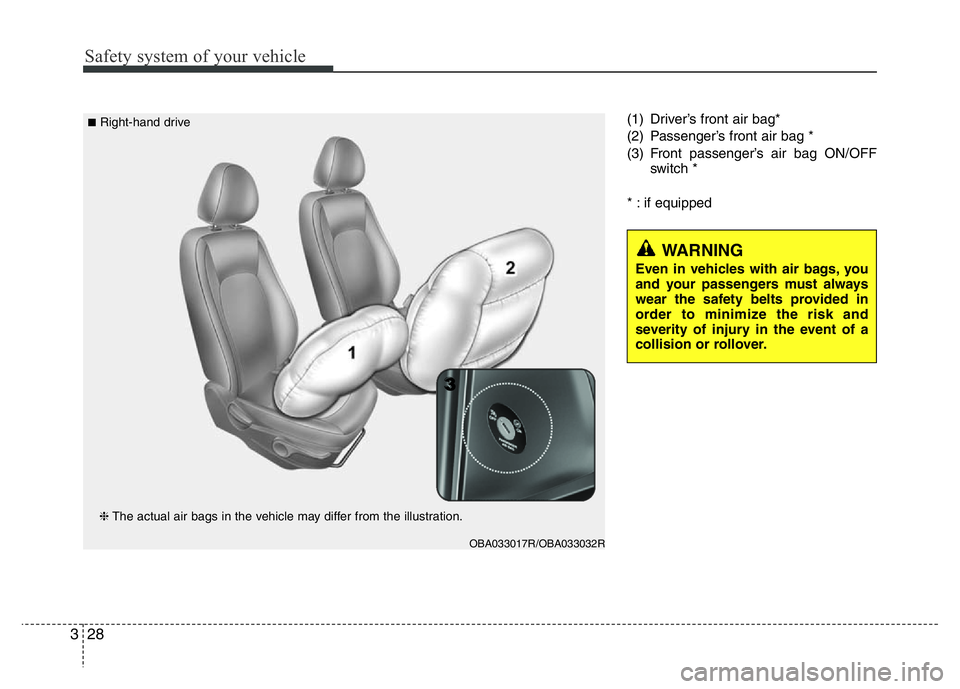
Safety system of your vehicle
28 3
(1) Driver’s front air bag*
(2) Passenger’s front air bag *
(3) Front passenger’s air bag ON/OFF
switch *
* : if equipped
WARNING
Even in vehicles with air bags, you
and your passengers must always
wear the safety belts provided in
order to minimize the risk and
severity of injury in the event of a
collision or rollover.
❈The actual air bags in the vehicle may differ from the illustration.
■Right-hand drive
OBA033017R/OBA033032R
3 3
Page 45 of 343
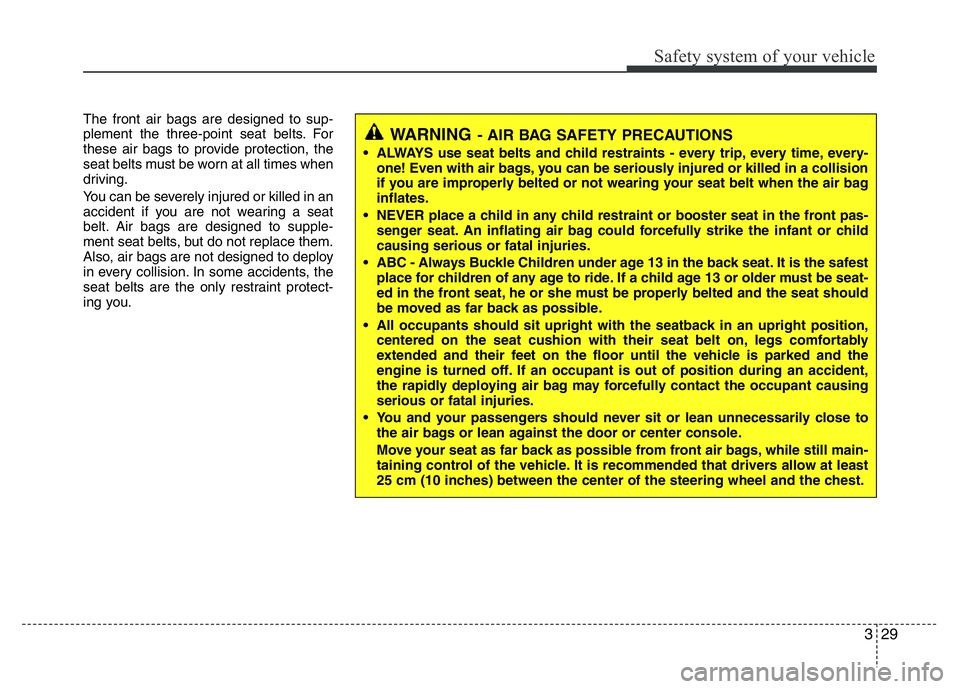
329
Safety system of your vehicle
The front air bags are designed to sup-
plement the three-point seat belts. For
these air bags to provide protection, the
seat belts must be worn at all times when
driving.
You can be severely injured or killed in an
accident if you are not wearing a seat
belt. Air bags are designed to supple-
ment seat belts, but do not replace them.
Also, air bags are not designed to deploy
in every collision. In some accidents, the
seat belts are the only restraint protect-
ing you.
WARNING- AIR BAG SAFETY PRECAUTIONS
• ALWAYS use seat belts and child restraints - every trip, every time, every-
one! Even with air bags, you can be seriously injured or killed in a collision
if you are improperly belted or not wearing your seat belt when the air bag
inflates.
• NEVER place a child in any child restraint or booster seat in the front pas-
senger seat. An inflating air bag could forcefully strike the infant or child
causing serious or fatal injuries.
• ABC - Always Buckle Children under age 13 in the back seat. It is the safest
place for children of any age to ride. If a child age 13 or older must be seat-
ed in the front seat, he or she must be properly belted and the seat should
be moved as far back as possible.
• All occupants should sit upright with the seatback in an upright position,
centered on the seat cushion with their seat belt on, legs comfortably
extended and their feet on the floor until the vehicle is parked and the
engine is turned off. If an occupant is out of position during an accident,
the rapidly deploying air bag may forcefully contact the occupant causing
serious or fatal injuries.
• You and your passengers should never sit or lean unnecessarily close to
the air bags or lean against the door or center console.
Move your seat as far back as possible from front air bags, while still main-
taining control of the vehicle. It is recommended that drivers allow at least
25 cm (10 inches) between the center of the steering wheel and the chest.
Page 46 of 343
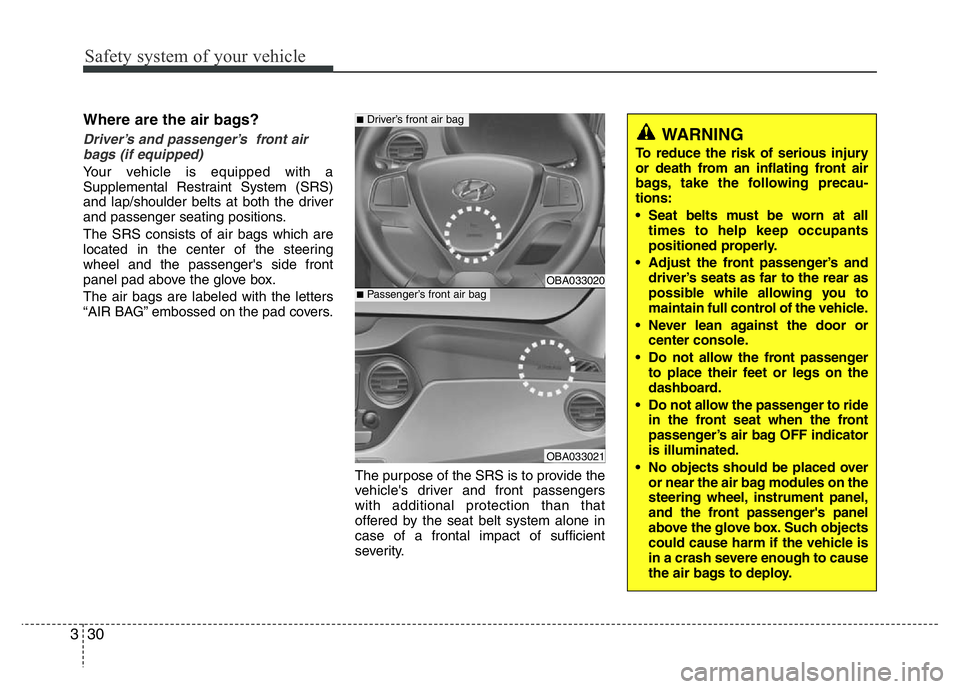
Safety system of your vehicle
30 3
Where are the air bags?
Driver’s and passenger’s front air
bags (if equipped)
Your vehicle is equipped with a
Supplemental Restraint System (SRS)
and lap/shoulder belts at both the driver
and passenger seating positions.
The SRS consists of air bags which are
located in the center of the steering
wheel and the passenger's side front
panel pad above the glove box.
The air bags are labeled with the letters
“AIR BAG” embossed on the pad covers.
The purpose of the SRS is to provide the
vehicle's driver and front passengers
with additional protection than that
offered by the seat belt system alone in
case of a frontal impact of sufficient
severity.
WARNING
To reduce the risk of serious injury
or death from an inflating front air
bags, take the following precau-
tions:
• Seat belts must be worn at all
times to help keep occupants
positioned properly.
• Adjust the front passenger’s and
driver’s seats as far to the rear as
possible while allowing you to
maintain full control of the vehicle.
• Never lean against the door or
center console.
• Do not allow the front passenger
to place their feet or legs on the
dashboard.
• Do not allow the passenger to ride
in the front seat when the front
passenger’s air bag OFF indicator
is illuminated.
• No objects should be placed over
or near the air bag modules on the
steering wheel, instrument panel,
and the front passenger's panel
above the glove box. Such objects
could cause harm if the vehicle is
in a crash severe enough to cause
the air bags to deploy.
OBA033020
OBA033021
■Driver’s front air bag
■Passenger’s front air bag
Page 47 of 343

331
Safety system of your vehicle
OBA033013R\ OBA033013\ ■
Left-hand drive■Right-hand drive
How does the air bags system operate?
The SRS consists of the following components:
1. Driver's front air bag module*
2. Passenger's front air bag module*
3. Pre-tensioner seatbelt system*
4. Air bag warning light*
5. SRS control module (SRSCM)*
6. Front impact sensors*7. Passenger’s front air bag ON/OFF indicator *
8. Passenger’s front air bag ON/OFF switch*
*: if equipped
The SRSCM continually monitors all SRS components while
the ignition switch is ON to determine if a crash impact is
severe enough to require air bag deployment or pre-tensioner
seat belt deployment.
Page 48 of 343

Safety system of your vehicle
32 3
SRS warning light
The SRS (Supplement Restraint System)
air bag warning light on the instrument
panel displays the air bag symbol depicted
in the illustration. The system checks the
air bag electrical system for malfunctions.
The light indicates that there is a potential
problem with your air bag system.During a moderate to severe frontal colli-
sion, sensors will detect the vehicle’s
rapid deceleration. If the rate of deceler-
ation is high enough, the control unit will
inflate the front air bags.
The front air bags help protect the driver
and front passenger by responding to
frontal impacts in which seat belts alone
cannot provide adequate restraint. When
needed, the side air bags help provide
protection in the event of a side impact or
rollover by supporting the side upper
body area.
• Air bags are activated (able to inflate if
necessary) only when the ignition
switch is in the ON position.
• Air bags inflate in the event of a severe
frontal or side collision to help protect
the occupants from serious physical
injury.
• There is no single speed at which the
air bags will inflate. Generally, air bags
are designed to inflate based upon the
severity of a collision and its direction.
These two factors determine whether
the sensors produce an electronic
deployment/inflation signal.
WARNING
If your SRS malfunctions, the air bag
may not inflate properly during an
accident increasing the risk of seri-
ous injury or death.
If any of the following conditions
occur, your SRS is malfunctioning:
• The light does not turn on for
approximately six seconds when
the ignition switch is placed in
the ON position.
• The light stays on after illuminat-
ing for approximately six sec-
onds.
• The light comes on while the
vehicle is in motion.
(Continued)
(Continued)
• The light blinks when the engine
is running.
We recommend that an authorized
HYUNDAI dealer inspect the SRS as
soon as possible if any of these
conditions occur.
Page 50 of 343
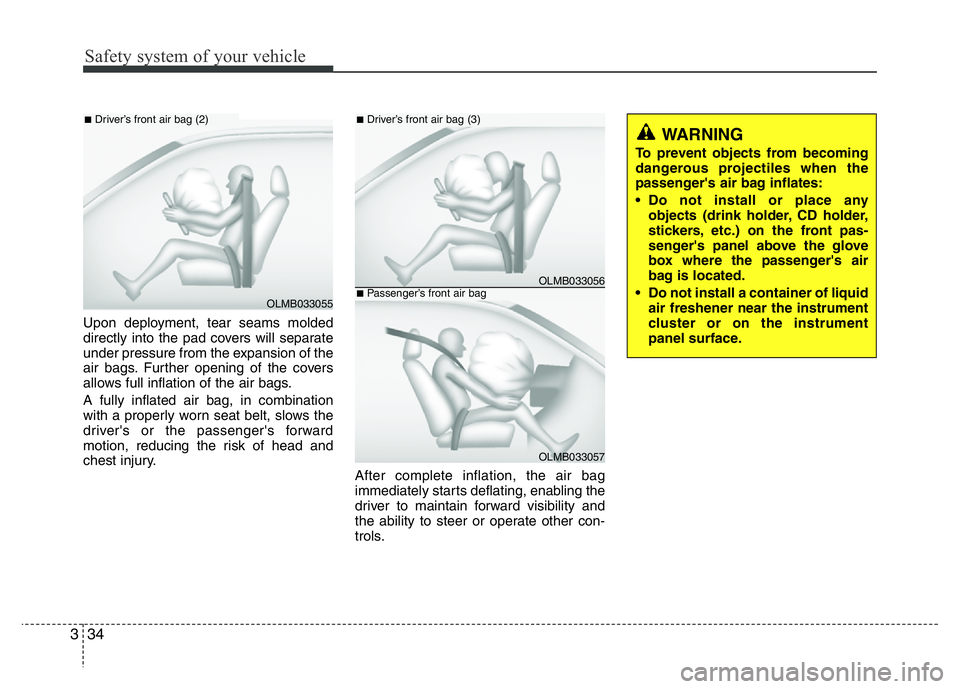
Safety system of your vehicle
34 3
Upon deployment, tear seams molded
directly into the pad covers will separate
under pressure from the expansion of the
air bags. Further opening of the covers
allows full inflation of the air bags.
A fully inflated air bag, in combination
with a properly worn seat belt, slows the
driver's or the passenger's forward
motion, reducing the risk of head and
chest injury.
After complete inflation, the air bag
immediately starts deflating, enabling the
driver to maintain forward visibility and
the ability to steer or operate other con-
trols.
OLMB033055
■Driver’s front air bag (2)
OLMB033056
■Driver’s front air bag (3)
OLMB033057
■Passenger’s front air bag
WARNING
To prevent objects from becoming
dangerous projectiles when the
passenger's air bag inflates:
• Do not install or place any
objects (drink holder, CD holder,
stickers, etc.) on the front pas-
senger's panel above the glove
box where the passenger's air
bag is located.
• Do not install a container of liquid
air freshener near the instrument
cluster or on the instrument
panel surface.
Page 51 of 343
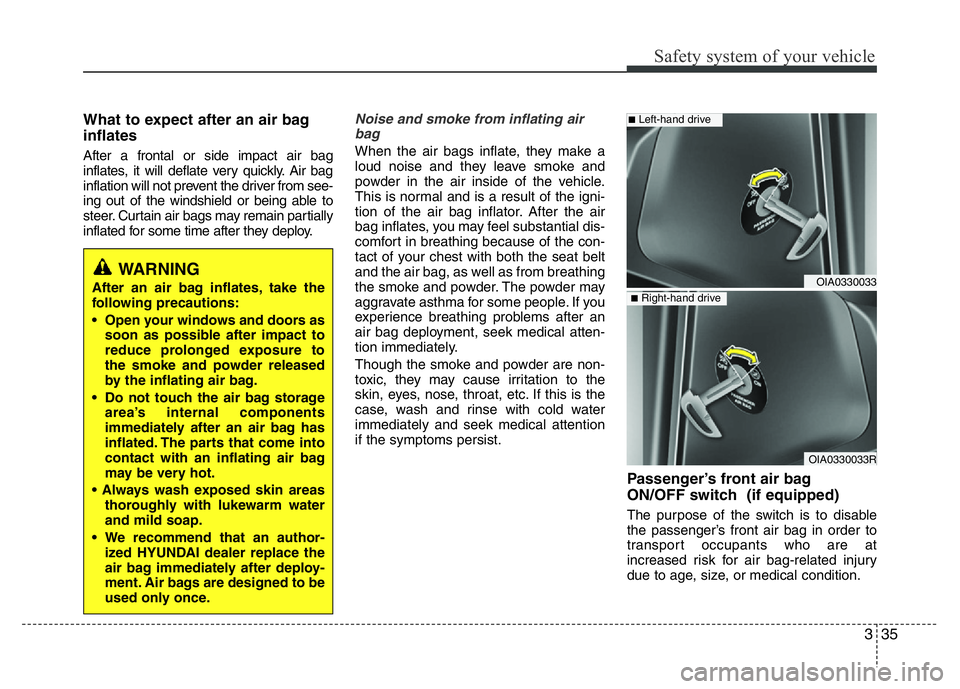
335
Safety system of your vehicle
What to expect after an air bag
inflates
After a frontal or side impact air bag
inflates, it will deflate very quickly. Air bag
inflation will not prevent the driver from see-
ing out of the windshield or being able to
steer. Curtain air bags may remain partially
inflated for some time after they deploy.
Noise and smoke from inflating air
bag
When the air bags inflate, they make a
loud noise and they leave smoke and
powder in the air inside of the vehicle.
This is normal and is a result of the igni-
tion of the air bag inflator. After the air
bag inflates, you may feel substantial dis-
comfort in breathing because of the con-
tact of your chest with both the seat belt
and the air bag, as well as from breathing
the smoke and powder. The powder may
aggravate asthma for some people. If you
experience breathing problems after an
air bag deployment, seek medical atten-
tion immediately.
Though the smoke and powder are non-
toxic, they may cause irritation to the
skin, eyes, nose, throat, etc. If this is the
case, wash and rinse with cold water
immediately and seek medical attention
if the symptoms persist.
Passenger’s front air bag
ON/OFF switch (if equipped)
The purpose of the switch is to disable
the passenger’s front air bag in order to
transport occupants who are at
increased risk for air bag-related injury
due to age, size, or medical condition.
WARNING
After an air bag inflates, take the
following precautions:
• Open your windows and doors as
soon as possible after impact to
reduce prolonged exposure to
the smoke and powder released
by the inflating air bag.
• Do not touch the air bag storage
area’s internal components
immediately after an air bag has
inflated. The parts that come into
contact with an inflating air bag
may be very hot.
• Always wash exposed skin areas
thoroughly with lukewarm water
and mild soap.
• We recommend that an author-
ized HYUNDAI dealer replace the
air bag immediately after deploy-
ment. Air bags are designed to be
used only once.
OIA0330033R
OIA0330033
■Left-hand drive
■Right-hand drive
Page 52 of 343
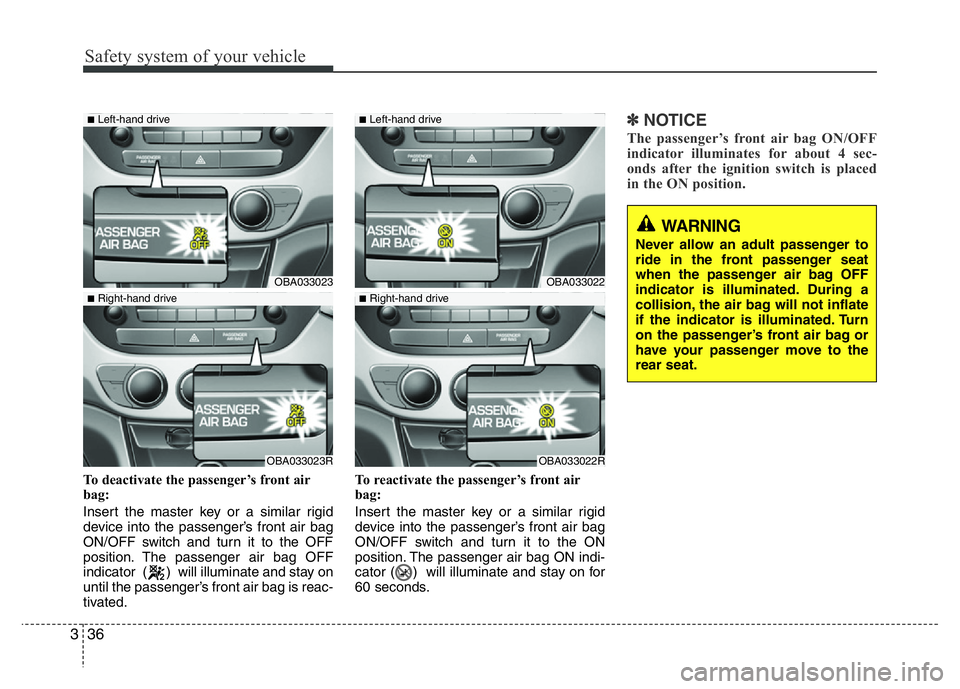
Safety system of your vehicle
36 3
To deactivate the passenger’s front air
bag:
Insert the master key or a similar rigid
device into the passenger’s front air bag
ON/OFF switch and turn it to the OFF
position. The passenger air bag OFF
indicator ( ) will illuminate and stay on
until the passenger’s front air bag is reac-
tivated.To reactivate the passenger’s front air
bag:
Insert the master key or a similar rigid
device into the passenger’s front air bag
ON/OFF switch and turn it to the ON
position. The passenger air bag ON indi-
cator ( ) will illuminate and stay on for
60 seconds.
✽NOTICE
The passenger’s front air bag ON/OFF
indicator illuminates for about 4 sec-
onds after the ignition switch is placed
in the ON position.
OBA033023OBA033022
OBA033023ROBA033022R
WARNING
Never allow an adult passenger to
ride in the front passenger seat
when the passenger air bag OFF
indicator is illuminated. During a
collision, the air bag will not inflate
if the indicator is illuminated. Turn
on the passenger’s front air bag or
have your passenger move to the
rear seat.
■Left-hand drive■Left-hand drive
■Right-hand drive■Right-hand drive